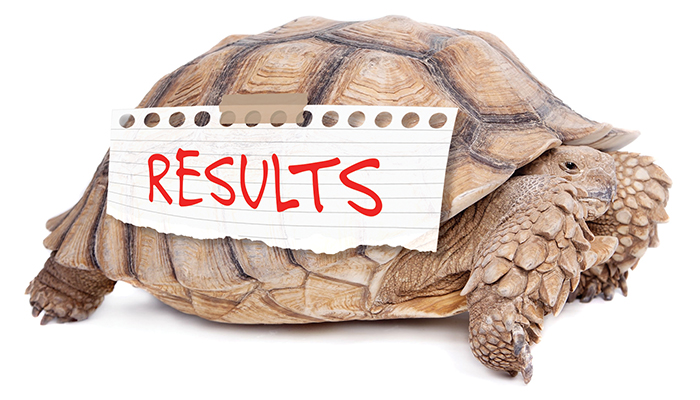All
Drug Test Results Can Take a Long Time
by Richard Pummell, Foley Carrier Services

It is well known that many DOT-regulated businesses employing CDL drivers have a difficult time finding—and hanging on to—qualified drivers. Once a good candidate pops up, hiring managers are anxious to get their prospective employee in the driver’s seat. Oftentimes, after the barrage of paperwork, driving records and background checks have been completed, the only item left is the pre-employment drug test result.
Waiting on a drug test result can cost money and cause stress. In order to understand why results are sometimes delayed, we need to understand DOT-regulated drug testing procedures.
What happens after a driver takes a drug test. After a collection is complete, the urine specimen is sealed and sent to the laboratory, where it will be tested for drugs in the order it is received. The laboratory then sends the drug test result to the Medical Review Office (MRO). At that point, providing the MRO has received its copy of the Federal Custody & Control Form (CCF), they can report the result out to the company’s Designated Employer Representative (DER).
Problems that can hold up a drug test result. The process described above ordinarily takes between 24 and 72 hours, provided the result is negative and there are no other problems that may hold up the process. However, there are times when a specimen does take longer to report out to the company. Below are some situations where this may occur.
Problem No. 1: Non-Negative Test Result
Non-negative specimens require further analysis and procedures and therefore take longer to process. Non-negative circumstances include the following:
Positive Test Result: When a specimen tests positive for controlled substances, there are additional tests the laboratory must complete. This includes measuring the specific levels—or amount—of controlled substance(s) in the specimen.
Once the laboratory has reported a positive test to the MRO, the MRO must attempt to contact the donor to conduct an interview in order to verify whether there is any medical reason (such as a valid prescription) for the positive result. The MRO must attempt to contact the donor at least three times within 24 hours. If no contact is made, the MRO must then contact the DER so he or she can attempt to reach the donor. If no contact is made after 10 days, the result will report out as a “no-contact” positive.
If the MRO is able to conduct the interview and the donor claims there is a medical reason for the positive, he or she has up to five days to provide a valid prescription.
Adulterated and/or Substituted Specimens: In addition to controlled substances, the laboratory tests the specimen for compounds and levels to ensure that it is consistent with regular human urine. If values are either significantly high or low, or if it contains a substance that is not normally found in human urine, the laboratory may determine that the specimen was intentionally tampered with. When this occurs, it is considered a refusal to test.
Problem No. 2: The MRO doesn’t receive its copy of the CCF
In order to verify that there were no critical errors during the collection process, the MRO must receive a legible copy of the CCF from the collection site. If the CCF is misplaced or sent to an incorrect address, this will hold up the MRO review process and delay the result.
Problem No. 3: The specimen is delayed in transit to the laboratory
Unforeseen circumstances, such as inclement weather or traffic, may delay the delivery of a specimen. Likewise, a drug test that is taken just prior to a holiday may move the process more slowly.
Speeding Up the Process
Although there is no way to accelerate the laboratory testing processes or control any unforeseen circumstances, there are a couple of steps that may help expedite a result:
Obtain and retain the employee and/or the employer copy of the CCF – Following a collection, the collector should give the donor his or her copy of the CCF, as well as send a copy to the employer. If the MRO has not received a legible copy of the CCF from the collection site, the employee or employer copy will often suffice.
Follow-up with the collection site – After an individual has taken a drug test, follow-up with the collection site to ensure they have sent the specimen to the laboratory, and have forwarded the CCF to the MRO. This is also a good time to ensure you obtain your copy of the CCF.
Fortunately, there are companies such as Foley to help business owners navigate through complicated drug-testing procedures. Please contact us at
(800) 253-5506, and check out our website at www.foleyservices.com/employee-background-checks for more information.
Related Posts
 U.S. Competing to Secure Critical Minerals
U.S. Competing to Secure Critical Minerals
Posted on June 16, 2025
 The Clean Air Act, the EPA, and State Regulations
The Clean Air Act, the EPA, and State Regulations
Posted on May 14, 2025
 Day Tanks Support Back-up Generators in Extreme Conditions
Day Tanks Support Back-up Generators in Extreme Conditions
Posted on March 10, 2025
 Major Breakthrough in Lithium-Ion Batteries
Major Breakthrough in Lithium-Ion Batteries
Posted on February 12, 2025
Enter your email to receive important news and article updates.
